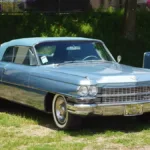If you’re seeing blue smoke coming from your car’s exhaust, it’s a sign that something isn’t quite right. But don’t worry, you’re in the right place to get some clarity. This article will break down the reasons behind blue smoke, its common causes, and how you can address the issue before it turns into a costly repair.
What Does Blue Smoke from Exhaust Mean?
Blue smoke from the exhaust usually points to one major issue: oil is burning in the engine. This happens when engine oil leaks into the combustion chamber and mixes with the air-fuel mixture. Instead of producing a clean burn, the oil burns with the fuel, leading to that unmistakable blue-tinted smoke. But what causes this leak? Let’s dive into the details.
Common Causes of Blue Smoke
Worn Valve Seals
Valve seals prevent oil from entering the engine’s combustion chamber. When these seals wear out, oil slips through and burns along with the fuel, resulting in blue smoke.
Damaged Piston Rings
The piston rings act as a seal between the combustion chamber and the crankcase. When these rings wear out or break, oil can leak into the combustion chamber, causing the engine to burn oil.
Blown Head Gasket
A blown head gasket can allow oil to leak into the cylinders. This leakage causes blue smoke to billow out of the exhaust, especially when the engine is running at higher RPMs.
PCV (Positive Crankcase Ventilation) System Issues
The PCV system regulates engine pressure and prevents oil from escaping. If this system becomes clogged or faulty, oil can be pushed into places it shouldn’t be, resulting in blue smoke.
Turbocharger Failure
If your vehicle is turbocharged, blue smoke can signal that oil is leaking into the intake or exhaust. A worn turbo seal often leads to this issue.
When Do You Typically See Blue Smoke?

At Startup
If blue smoke appears just as you start the car and then fades away, it could be a sign of worn valve seals. The oil leaks into the combustion chamber while the car is off and burns up when you start it.
During Acceleration
Blue smoke under heavy acceleration is often linked to worn piston rings. As the engine revs higher, oil leaks past the rings and burns in the combustion chamber.
At Idle
Seeing blue smoke while the car is idling? A faulty PCV system might be to blame. When the engine is running at low speeds, a clogged or malfunctioning PCV valve can lead to oil burning.
The Difference Between Blue, White, and Black Smoke
It’s crucial to differentiate blue smoke from other types of exhaust smoke. Each color points to a different issue:
- White Smoke: Usually caused by coolant entering the combustion chamber, indicating a blown head gasket or cracked cylinder head.
- Black Smoke: Indicates the engine is burning too much fuel, which could result from a clogged air filter or malfunctioning fuel injectors.
- Blue Smoke: Points to burning oil, as explained earlier.
Understanding these differences will help you diagnose the issue more accurately.
How to Fix Blue Smoke from Exhaust
Check and Replace Worn Valve Seals
Valve seals can wear down over time, especially in older vehicles. If you suspect your seals are the problem, it’s time for a replacement. Although this isn’t a quick DIY fix, a mechanic can easily replace them for you.
Repair or Replace Piston Rings
If the blue smoke appears when accelerating, damaged piston rings could be the culprit. Unfortunately, replacing piston rings is a labor-intensive job that requires professional help, as it involves taking apart the engine.
Inspect and Replace the PCV Valve
A clogged or faulty PCV valve can lead to blue smoke at idle. Luckily, this is one of the easier and more affordable fixes. Simply replace the PCV valve, and your problem might disappear.
Fix a Blown Head Gasket
A blown head gasket can be a serious issue, often resulting in blue smoke. If you suspect this is the cause, take your vehicle to a mechanic immediately. This repair can be costly but ignoring it could lead to catastrophic engine damage.
Address Turbocharger Issues
Turbochargers are prone to oil leaks if their seals wear out. If your car is turbocharged and emitting blue smoke, have the turbo inspected for oil leakage and replace the seals if necessary.
Preventing Blue Smoke: Maintenance Tips
Regular Oil Changes
Old or contaminated oil can accelerate engine wear, leading to problems like blue smoke. Stick to your vehicle’s recommended oil change intervals to keep everything running smoothly.
Use the Right Oil
Using the wrong type of oil for your engine can cause more harm than good. Always ensure you’re using the oil recommended by your vehicle manufacturer to prevent leaks and engine damage.
Keep an Eye on Oil Levels
Low oil levels can lead to increased engine wear and oil burning. Regularly check your oil levels to ensure your engine is adequately lubricated.
Monitor Engine Performance
If your car’s performance feels off, it might be a sign of engine trouble. Catching issues early can save you from expensive repairs down the line, so stay aware of any changes in how your vehicle runs.
What Happens if You Ignore Blue Smoke?
Ignoring blue smoke from your exhaust can have severe consequences. Over time, the underlying issue—whether it’s worn seals, piston rings, or a blown gasket—will get worse. Continued oil burning can lead to engine overheating, reduced performance, and, ultimately, total engine failure. It’s always best to address the issue as soon as possible.
Can Blue Smoke be a Temporary Issue?

In some rare cases, blue smoke might be temporary, like when using an oil treatment or after an oil change. If the smoke disappears after a few minutes of driving, it may not indicate a severe problem. However, if the smoke persists, it’s essential to investigate further.
Conclusion
Blue smoke from your exhaust is usually a sign that oil is burning in your engine—an issue that shouldn’t be ignored. Whether it’s due to worn valve seals, piston rings, or a faulty PCV system, addressing the problem early can save you from more expensive repairs down the road. Regular maintenance, like oil changes and using the correct oil, can help prevent this issue from happening in the first place.
FAQs
1. What does blue smoke from the exhaust mean?
Blue smoke means your engine is burning oil due to leaks, often from worn seals, damaged piston rings, or a blown head gasket.
2. Can I drive with blue smoke from my exhaust?
It’s best not to. Driving with blue smoke can cause more engine damage and lead to costly repairs. Get it checked out ASAP.
3. Is blue smoke dangerous to my engine?
Yes, blue smoke indicates that oil is leaking into the combustion chamber. If left untreated, this can cause engine failure over time.
4. How much does it cost to fix blue smoke issues?
Costs vary depending on the cause. Replacing a PCV valve is cheap, but fixing piston rings or a blown head gasket can be expensive.
5. Can an oil change fix blue smoke?
In some cases, an oil change might resolve temporary blue smoke, but if the issue persists, it’s likely a sign of a more significant engine problem.
Also Read: Car Hesitates When Accelerating: Causes, Solutions, and Tips







